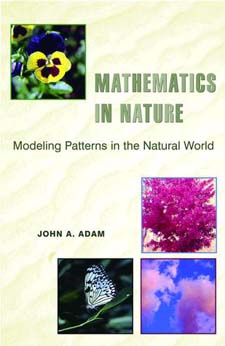- Home
- Numicon NZ Website
- About Us
- Numicon
- Professional Development/Events
- FREE online PD recordings
- Login
- Contact
- Join Mailing List
- Conference 2026
Mathematics in Nature: Modeling Patterns in the Natural World, by John A Adam
> Home > Shop > Books > All Books from Edushop > Mathematics in Nature: Modeling Patterns in the Natural World, by John A Adam
From rainbows, river meanders, and shadows to spider webs, honeycombs, and the markings on animal coats, the visible world is full of patterns that can be described mathematically. Examining such readily observable phenomena, this book introduces readers to the beauty of nature as revealed by mathematics and the beauty of mathematics as revealed in nature.
Price:
NZ$ 50.00 excluding GST
NZ$ 57.50 including GST
B7965
Contact us for availability
Special Order
Generously illustrated, written in an informal style, and replete with examples from everyday life, Mathematics in Nature is an excellent and undaunting introduction to the ideas and methods of mathematical modeling. It illustrates how mathematics can be used to formulate and solve puzzles observed in nature and to interpret the solutions. In the process, it teaches such topics as the art of estimation and the effects of scale, particularly what happens as things get bigger. Readers will develop an understanding of the symbiosis that exists between basic scientific principles and their mathematical expressions as well as a deeper appreciation for such natural phenomena as cloud formations, haloes and glories, tree heights and leaf patterns, butterfly and moth wings, and even puddles and mud cracks.
Developed out of a university course, this book makes an ideal supplemental text for courses in applied mathematics and mathematical modeling. It will also appeal to mathematics educators and enthusiasts at all levels, and is designed so that it can be dipped into at leisure.
Endorsements: 'Have you wondered how rainbows or sand dunes form? Does it puzzle you why drying mud forms polygonally shaped cracks? Can you explain the patterns on a butterfly's wings or how birds fly? In this delightful book, John Adam invites us to question and to share his enthusiasm for developing mathematical models to explore a wide range of everyday natural phenomena. Mathematics in Nature can be used as a text on mathematical modeling or as a book to dip into and encourage us to observe and wonder at the beauty of nature. It has the potential of becoming a classic.'--- Brian Sleeman, University of Leeds.
'This is a book that I will want to keep close to hand so that I will not be stumped by all those seemingly simple yet subtle questions about nature: Why can fleas jump so high? Why is visibility better in rain than in fog? Why does a river meander? How high can trees grow? But it is much more than a compendium of useful facts and explanations. It is the clearest guide I have seen to the art of conceptualizing, simplifying, and modeling natural phenomena-no less than an exegesis on how good quantitative science is done.'--Phillip Ball, Consultant Editor, Nature
'Mathematics in Nature leads the calculus-literate reader on a vigorous tour of nature's visible patterns--from the radiator-sailed dinosaur Dimetrodon to fracturing of dried mud and ceramic glazes, from the dispersion of rainbows and iridescence of beetles to the pearling of spider silk. Eschewing phenomena that are too small to see or too large to grasp, Adam shows how elementary college mathematics, rigorously applied, can give precise expression to everyday natural phenomena. His extraordinary range of examples and meticulous explanations document mathematics' wonderful capacity to describe and explain nature's patterns.'--Lynn Arthur Steen, St. Olaf College 'This work is outstanding! The color photographs are beautiful. The writing style is splendid.'--- Robert B. Banks, author of Towing Icebergs, Falling Dominoes, and Other Adventures in Applied Mathematics
'This is a unique, even great book. It is in the spirit of a number of books on topics like symmetry and chaos that look at mathematics in the context of visually striking natural and other phenomena but is more broadly based. The author leads with the phenomena and follows with the math, making the book accessible to a wider audience while still appealing to math students and faculty.'--- Frank Wattenberg
View your shopping basket or Browse other items in All Books from Edushop.

